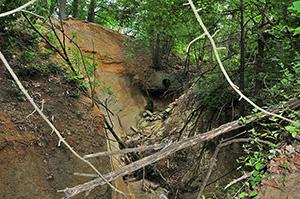2013 Community Stream Stewards
Restoring Aging Pipes and Ponds Talk
with Bel Pachhai, PWC Watershed Management
presented on September 5 2013
Review by Kelly Moravec
 On September 5 seventeen people gathered to participate in the first 2013 Stream Stewards lecture, The Evolution of Stormwater Management in Communities, sponsored by Prince William Conservation Alliance (PWCA). On September 5 seventeen people gathered to participate in the first 2013 Stream Stewards lecture, The Evolution of Stormwater Management in Communities, sponsored by Prince William Conservation Alliance (PWCA).
The lecture was held at Bull Run Unitarian Church in Manassas, from 7:30 - 9:00 p.m. The lecture slides are available on the PWCA website here.
Bel Pachhai, Environmental Engineer with Public Works Watershed Management Branch, presented a fascinating exploration of pipes and ponds in older communities, and led a lively discussion on the history and impact of stormwater management in the county.
Mr. Pachhai described how communities are learning from mother nature and evolving towards a “green” infrastructure.
History of Stormwater Management
Stormwater management really started after World War II, and before 1970, the goal was to get the water out of an area quickly. Catch pits, pipes, and channels were used to funnel the water away. These methods caused downstream flooding, soil erosion, and other problems.
From around the 1980s, dry detention ponds were used to control flows associated with 2-year and 10-year storms from the developed sites, and riser structure controlled how much water would be held in a pond before going into the pipe. Generally, emergency spillways are provided in these ponds to safely pass the extreme storm events.
Prior to the 1980s, stormwater management was considered as water quantity management – taking the water away from developments without causing flooding and erosion in the downstream properties and channels.
Degrading water quality finally raised concerns in the 1980s, as the water from developed areas flowing in to streams, rivers, and lakes caused huge algal blooms and fish decline due to increased level of pollutants such as phosphorous, nitrogen and sediments. Then, quality and quantity became dual components of stormwater management.
Today, there are various Best Management Practices (BMP) in place to remove pollutants from stormwater with various level of efficiencies. For example: Extended detention ponds have a phosphorus removal efficiency of 15-31%. For wet ponds, the level is 50-70% and constructed wetlands have a phosphorus removal efficiency of 50-80%.
The cost and effort of maintaining the different types of stormwater management methods are all high. For dry extended detention ponds and wet ponds, you have to remove sediment. For constructed wetlands, you need to occasionally harvest the vegetation and replace dead plants with new plants and remove invasive species. Many people do not think about the necessity to manage the vegetation, but phosphorous is absorbed through plants, so you should harvest the plants on a regular basis and use the nutrient elsewhere.
Stormwater Management in Prince William County
It is local governments’ responsibility to manage stormwater run-off; however, there are federal and state statutes governing the total maximum daily loads of pollutants in order to mitigate the degrading water quality of the nation’s water bodies.
In Prince William County, there are now stricter regulations for stormwater management in new developments, so the county is focusing efforts to retrofit ponds on existing developments along. The Municipal Separate System (MS4) program imposes greater regulations based on a specified timeline. The goal is to reduce 10-30 percent phosphorous and nitrogen from the existing development within 15 years. Retrofitting existing stormwater management facilities is one of the strategies needed to achieve this goal.
In the green infrastructure approach, new developments are expected to reduce impervious area (including road size), cluster development, and create rain gardens to reduce the volume of rainwater run-off. Many developments (not subject to the new regulations) mostly use ponds for stormwater management. There are an estimated 1500 ponds in the county.
Prince William is now involved with retrofitting existing stormwater facilities to improve their function by adding new parts or devices that were not available or known when the facility was built. Retrofitting is designed to improve the water quality functions along with remedy the deficiencies in the pond.
Various options are available to retrofit the pond, such as raising embankments, enlarging the footprint of the pond, providing micro pools with hooded low flow intake, safety and maintenance benches, and permanent pools with shallow marsh emergent wetlands. All of these options, usually used in combination, provide more time for water to stick around in the area and create a winding path to the outlet pipe. |